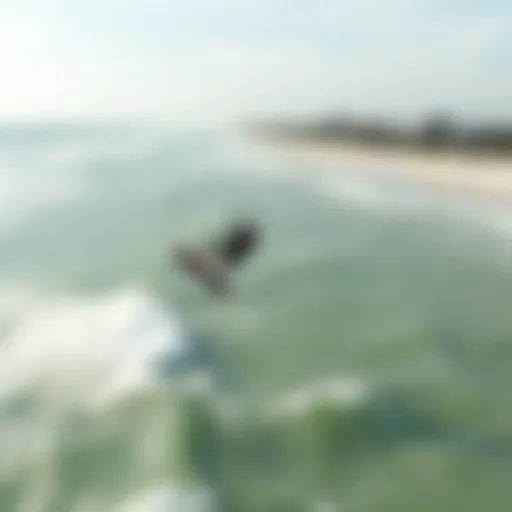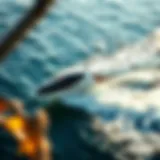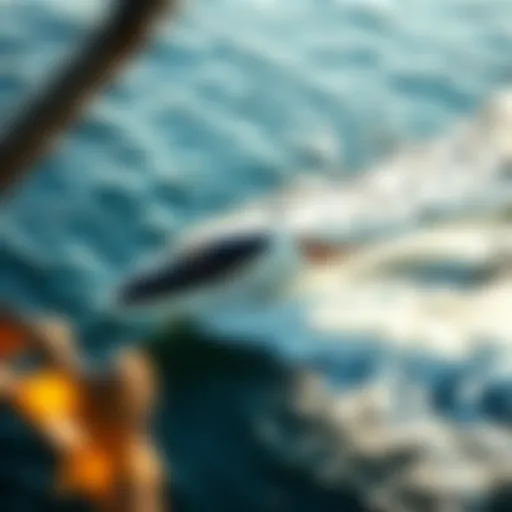The Pinnacle of Kiteboarding: Top Kites Revealed
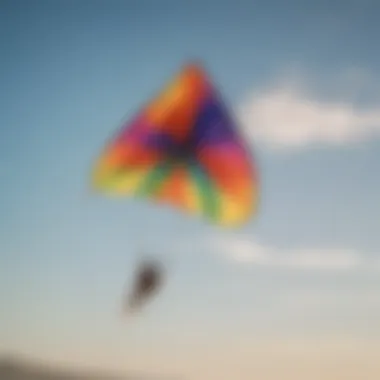

Intro
When it comes to kiteboarding, the kite is the heart of the experience. The choice of kite can make or break a session on the water. Whether you're zipping along a flat lake or tackling waves in the ocean, understanding the nuances behind kite selection is paramount.
In this guide, we'll peel back the layers of kiteboarding gear, focusing on what makes certain kites rise above the rest. From various types of kites and boards to tips for enhancing your skills, we aim to provide a comprehensive look at the essentials you need to make informed decisions. With expert insights and community-driven feedback, this article is crafted for kiteboarding enthusiasts, instructors, and event organizers who seek to deepen their knowledge and elevate their riding experience.
Gear Selection
Selecting the right gear is akin to pairing the right wine with a meal: it can enhance the overall experience significantly. As with any sport, a deep understanding of the equipment is essential for optimal performance.
Types of Kites
The world of kites is as diverse as the riders themselves. Understanding the differences among kites can help tailor your choice based on your riding style and the conditions you plan to encounter.
- C-Kites: Known for their powerful lift and predictable handling, C-Kites are ideal for freestyle riders. They excel in performing tricks yet require skill to manage in diverse winds.
- Bow Kites: These kites are popular among beginner and intermediate riders due to their incredible stability and upwind performance. Their design allows for a higher wind range, making them versatile across conditions.
- Delta Kites: These are a cross between C-kites and Bow kites, offering the best of both worlds—good lift and stability. This category is highly favored for those venturing into various styles of kiteboarding.
- Foil Kites: While they may not be everyone's cup of tea, foil kites are becoming more popular, particularly among those interested in light wind conditions. Their ability to generate lift even at lower speeds can open up a whole new facet of riding opportunities.
Choosing the Right Board
Once you've settled on your kite type, the next step is selecting the board. The right board complements your kite, enhancing control and maneuverability on the water.
- Directional Boards: These are designed specifically for wave riding. They allow you to surf waves comfortably and are typically favored by those who enjoy a more traditional surfing style.
- Twin Tip Boards: Most common in the kiteboarding world, twin tip boards are versatile and suitable for all riding styles. Their symmetrical design allows for riding in both directions, making them ideal for beginners and experts alike.
- Freestyle Boards: Tailored for those who focus on tricks, these boards tend to have a flatter profile, providing excellent pop off the water for jumps and aerial moves.
Understanding how your kite and board work together can significantly improve your performance, allowing you to make the most of your time on the water.
"The right combination of kite and board transforms a good ride into a great experience."
Skill Development
While gear selection is essential, no piece of equipment can substitute for skill and technique on the water. Mastering the fundamental techniques and continuously progressing can set you on a path to more advanced tricks and greater enjoyment.
Essential Techniques
Like any sport, the basics are crucial. Focusing on essential techniques early on can save you tons of frustration later. Here’s a list of key skills to develop:
- Body Positioning: Maintaining an active and balanced stance is crucial. Make sure your knees are bent and weight evenly distributed across your feet.
- Control of the Kite: Learning to handle the kite’s movement in both the air and on the water is vital for all maneuvers. Spend time practicing how to steer the kite through the wind window for better control.
- Edge Control: Understanding how to use your board's edge effectively will help you catch more speed and make smoother turns.
Progression Tips
Just like planting a seed and watching it grow, your skill in kiteboarding needs nurturing. Here are a few tips for steady progression:
- Practice Regularly: Consistency is key when developing skills. The more often you ride, the quicker you will improve.
- Set Goals: Whether it’s learning a new trick or improving your upwind skills, having clear goals can guide your practice sessions effectively.
- Seek Feedback: Don’t shy away from asking for tips from more experienced riders. A fresh set of eyes can offer valuable pointers to help you improve.
In the ever-evolving sport of kiteboarding, having the right gear and skills can significantly enhance the overall experience. Whether you're a beginner or a seasoned pro, understanding both aspects is critical for unleashing your full potential in harnessing the wind on a kiteboard.
Understanding Kiteboarding and Its Gear
Kiteboarding, often likened to a dance with the wind, demands a robust understanding of its fundamentals and the gear involved. This knowledge isn't merely academic; it's the bedrock on which kiteboarders build their skills and happiness in this exhilarating sport. Grasping the essentials of kiteboarding unlocks the door to enhanced performance, safety, and enjoyment on the water. The right equipment can make a world of difference, turning a mere outing into an unforgettable adventure.
The Essentials of Kiteboarding
At its core, kiteboarding melds elements of surfing, windsurfing, and paragliding, which may sound complex, but the essentials can be broken down.
- Kite: The heart of the sport. The kite creates lift, harnessing the wind's power. Understanding the various types of kites and their designs helps riders select the right one for their conditions.
- Board: Your interface with the water. Whether it’s a twin-tip, directional, or foiling board, each type serves a purpose based on the rider's style and the conditions they encounter.
- Control Bar and Lines: The bridge between rider and kite. This setup controls the kite’s movements and adjustments. Mastering this component can be the difference between a smooth ride and a wild ride.
- Safety Systems: Crucial for any kiteboarder. An understanding of safety releases and quick descent techniques can save lives in emergencies.
The blend of these elements along with a good grasp of wind conditions is indispensable for anyone looking to progress in kiteboarding. The right gear not only enhances performance but also assures safety, allowing riders to focus on improving their skills.
The Role of the Kite in Kiteboarding
The kite plays a monumental role in kiteboarding. It’s the primary source of power, and its design can significantly influence a rider's experience. Different kites serve various purposes, and understanding these can aid in making informed choices.
- Shape Matters: Kites come in various shapes including C-shape, bow, and delta. Each shape affects lift, power, and control.
- Size Also Counts: The size of the kite determines how much power it generates. Bigger kites capture more wind but can also be more challenging to control, especially for beginners.
- Wind Range: Not all kites are created equally in different wind conditions. Understanding the kite’s wind range will help riders maximize their time on the water while staying safe.
Furthermore, the kite's handling, responsiveness, and stability contribute to the overall riding experience. A well-functioning kite can enhance a rider's skills and make challenging conditions manageable.
"The kite is like an extension of your own body. Understanding its mechanics and characteristics transforms the kiteboarding experience into something vibrant and fluid."
In summary, mastering kiteboarding begins with understanding the gear that supports this sport. From the kite to safety systems, each piece is integral to an enjoyable and safe experience.
The fundamentals are not just about pieces of equipment; they also inspire confidence and enable riders to tackle challenges head-on, maximizing both performance and pleasure in the sport.
The Anatomy of a Kite
Understanding the anatomy of a kite is crucial for both newcomers and seasoned kiteboarders alike. Knowing the specific parts of a kite and their functions can greatly enhance a rider's performance on the water. The anatomy encompasses various components that work together to provide stability, control, and responsiveness while riding. In this section, we’ll explore the important elements of a kite, emphasizing their functionalities, advantages, and considerations, which ultimately influence your kiteboarding experience.
Key Components of a Kite
Leading Edge
The leading edge is the first part of the kite that touches the wind. Its aerodynamic shaping is vital as it sets the tone for how the kite responds. A smooth, robust leading edge allows for efficient airflow, which increases lift. A typical characteristic of high-quality leading edges is their durability; they’re often made from resilient materials that can withstand harsh conditions. This makes the leading edge an essential feature for kiteboarding, especially in choppy waters or strong winds. However, be wary of overly rigid designs, which might impede maneuverability in certain cases.
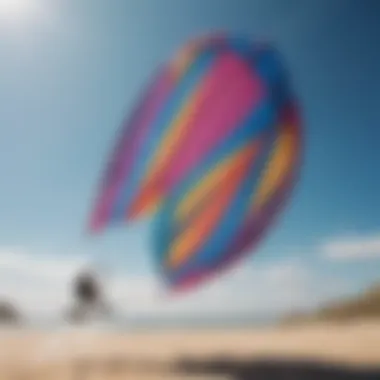

Trailing Edge
Opposite of the leading edge is the trailing edge, which is just as important. This part affects how the kite releases air, contributing to stability and control during flight. One of the key characteristics of a well-designed trailing edge is its tapered design, ensuring a smooth flow of air and reducing drag. As such, it is a popular choice among kiteboarders who value performance in tricky wind conditions. However, a trailing edge that’s too thin might wear and tear faster, which is something to keep in mind when selecting a kite.
Sail Fabric
The sail fabric is where it gets interesting. Depending on the type of fabric used, the performance of the kite can vary widely. Generally, high-quality kites utilize ripstop nylon or polyester fabrics, known for their strength and resistance to tearing. The weight of the fabric is another consideration; lighter fabrics improve responsiveness yet can compromise durability. Some brands introduce unique coatings on their sail fabrics to enhance UV resistance, helping to prolong the life of the kite when exposed to the elements. That said, always assess the fabric based on your riding frequency and style, as what works best for one might not suit another.
Understanding Kite Shape and Design
Kite shapes and designs are pivotal in determining performance characteristics like turning speed, stability, and the type of riding experience. The configuration of a kite can either enhance or limit a rider's ability, so understanding the different styles available is pertinent for anyone looking to elevate their kiteboarding game.
Flat Kites
Flat kites, characterized by their wide wingspan and low profile, are designed for stability. Their shape allows them to generate consistent power, making them ideal for beginners as well as riders looking to cruise. A notable feature is their ability to glide easily over the water, providing a forgiving ride. Flat kites excel in lighter wind conditions but might not perform well in high winds due to a tendency to fly less efficiently. Therefore, they should be matched carefully to the wind conditions.
C-Shape Kites
C-shape kites offer a different riding experience. With their more pronounced curve, these kites provide increased lift and better performance in waves. The unique feature of C-shape kites is their responsiveness during jumps, making them a popular option among freestyle riders. However, they can be tricky to handle in stronger winds for less experienced riders, requiring a more advanced skill set. Balancing agility and power, C-shape kites serve a specific niche in the kiteboarding world.
Hybrid Designs
Lastly, hybrid kites attempt to marry the benefits of flat and C-shape kites. They provide versatility, making them suitable for a wide range of riding styles. This shape promises a balance between control and power, an appealing aspect for many kiteboarders. Hybrids can tackle diverse conditions effectively; however, they may not perform as optimally as specialized designs in particular conditions. When choosing a kite, considering hybrids can be a practical approach for those who may frequently switch up their riding styles.
"Understanding the anatomy of your kite enables a deeper connection with the sport, unlocking better techniques and performance."
Material Innovations in Kite Production
In the realm of kiteboarding, materials play a pivotal role in defining the performance and durability of kites. As kite designs evolve, so does the technology behind the materials used in their production. This section aims to delve into the significant advancements made in kite fabrics and the overall impact of weight and durability on kiteboarding experiences.
Advancements in Kite Fabrics
Modern kite fabrics have come a long way from the traditional cloth. The focus has shifted to lightweight synthetic materials that not only enhance performance but also provide resilience. Notably, materials like ripstop nylon and polyester have become standard due to their excellent strength-to-weight ratio.
Some kites now incorporate advanced materials such as Dyneema and Spectra. These are incredibly strong yet light, which allows manufacturers to create kites that are easier to handle while maximizing power and lift.
Additionally, water-repellent coatings are increasingly common. These innovations help prevent water absorption, keeping the kite lightweight even in damp conditions. This is crucial because a heavier kite, laden with water, can hinder performance significantly.
Take note that the fabric's construction also matters. Multi-layered fabrics offer better protection against wear and tear from intense use over time. By combining different fibers and techniques, manufacturers have developed fabrics that can better withstand the rigors of the sport. As a result, kiteboarders enjoy not just improved performance, but also increased longevity from their equipment.
Impact of Weight and Durability
The weight and durability of a kite are intertwined. A lighter kite can catch the wind more easily and respond quickly to a rider's inputs, ultimately offering better handling. However, lighter doesn’t always mean less durable. Advances in material technology mean that we can have both.
- Weight Considerations: A lighter kite is often crucial for freestyle and wave riders, who require responsive kites that allow for quick maneuvers. When kites are built using lighter fabrics, they can go further without requiring a sky-high amount of wind power. This means that riders can enjoy their sessions even on less windy days, which is particularly appealing for casual kiters.
- Durability Factors: While lighter kites provide agility, they need to be robust enough to withstand the forces that kiteboarding entails. Innovations in stitching and reinforcement have minimized the risk of tearing or ripping compared to older models, ensuring kites can perform in harsher conditions.
Furthermore, the improved durability also translates to lower costs over time. Riders find themselves spending less on replacements which clearly makes for a more sustainable practice in their sport.
"The materials used in kite production have progressed significantly, allowing for performance gains that were once unimaginable."
To wrap it up, understanding material innovations is key for any kiteboarder who aims to elevate their performance. Knowing the difference between various fabrics, and recognizing how weight influences a kite's responsiveness and durability can help riders make informed choices about their gear, ultimately enhancing their kiteboarding journey.
Top Kite Brands and Their Offerings
When diving into kiteboarding, the choice of kite can make or break your experience on the water. This section brings to light the importance of selecting from top kite brands, each offering unique features, quality, and performance suited to various riding styles. Knowing the differences among leading manufacturers not only enhances understanding but greatly aids in informed decision-making for enthusiasts.
An Overview of Leading Manufacturers
In the competitive arena of kiteboarding, a few brands have carved out a reputation for excellence. Notable names such as Best, Naish, and North, have established themselves as leaders through consistent innovation and dedication to rider performance.
- Best has become synonymous with high-quality kites that excel in various riding conditions.
- Naish is often praised for its cutting-edge design and versatility, making it a go-to for riders at every skill level.
- North focuses on performance-driven designs that cater to advanced kiteboarders, fostering a community around high-end kite sports.
Each of these manufacturers brings something distinct to the table, whether it be focused innovation, rider inclusivity, or performance metrics.
Flagship Models Compared
When contrasting flagship models, it's essential to break down their performance features, versatility, and innovation. Let's delve into the three standout brands and their hallmark offerings.
Brand A’s Performance Features
Discussing Best's flagship kite model, one can't overlook its superior performance features. Designed with a focus on stability and speed, the kite’s high aspect ratio makes for efficient upwind performance. Key characteristic includes its user-friendly handling, allowing beginner riders to find their footing while enabling skilled riders to push limits.
A unique feature is its integrated safety system, which greatly enhances safety during intense conditions. While the kite excels in stability, some users have noted a slight trade-off in maneuverability compared to competitors.
Brand B’s Versatility
Naish offers a model celebrated widely for its versatility in different riding conditions. Its distinctive all-around design accommodates various disciplines – whether you’re into freeriding or instructional sessions. A noteworthy characteristic is the adaptability with changing wind conditions thanks to its variable bridle system.
Riders appreciate the lightweight construction, which promotes ease of transport while maintaining durability. However, some practitioners suggest that the kite might not reach the same performance heights in specialized disciplines as more focused models do, so it remains context-dependent.
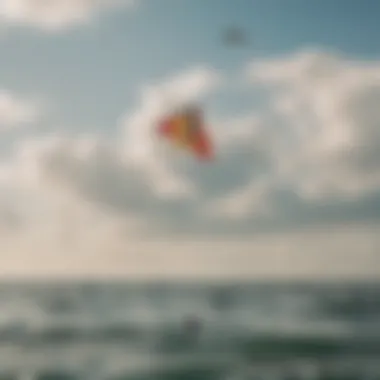

Brand ’s Innovation
With a forward-thinking approach, North has brought to market an innovative kite renowned for its performance-enhancing technology. Key here is the use of sustainable materials, aligning with environmental concerns while delivering unmatched durability against wear.
One of its standout features is the smart technology integration, which provides real-time data on performance metrics. This ensures riders stay informed about conditions and adjustments needed during sessions. However, the advanced tech comes at a cost, and users often find it significantly pricier than traditional options.
"Choosing the right kite from leading brands not only enhances performance but also aligns with personal style and commitment to the sport. Each brand's unique offerings can significantly influence the kiteboarding journey for enthusiasts, instructors, and event organizers alike."
In summary, understanding the top kite brands and their flagship models allows riders to tailor their kiteboarding experience per individual needs and preferences, ensuring they get the most out of their time on the water.
Choosing the Right Kite for Your Style
Selecting the right kite is crucial for kiteboarding enthusiasts because it can profoundly impact performance and enjoyment on the water. Each rider has a unique style, and understanding how to match the right kite to those preferences is essential. Not only does the kite's design influence how it behaves in different conditions, but it also enhances the overall experience of riding.
Determining Your Riding Style
Freeride
Freeride kiteboarding is about smooth sailing and embracing the thrill of the ride. This style allows riders to explore diverse conditions without being confined by specific tricks. The key characteristic here is versatility; it enables one to cruise around and enjoy the scenery, making it a popular choice among recreational kiteboarders.
A unique feature of freeride kites is their ability to generate power across a broad wind range. They tend to have faster, more forgiving characteristics that are user-friendly, making them ideal for those who want to enjoy the ride without the pressure of advanced tricks. The downside, however, may include lacking the specialized performance that more freestyle-oriented kites offer, particularly in executing complex maneuvers.
Freestyle
Freestyle kiteboarding revolves around tricks and aerial maneuvers. Riders aiming to perform flips, spins, or grabs will benefit from a kite designed for this specific activity. A key characteristic of freestyle kites is their responsive handling—they are built to ensure riders can easily execute tricks while maintaining control during high-powered jumps.
What sets freestyle kites apart is often their flat shape, which helps generate lift more efficiently when executing tricks. While they shine in performing, the trade-off may include reduced stability in choppy water conditions compared to freeride kites, which can be less forgiving for beginners.
Waves
For those who thrive in wave conditions, wave kites deliver unparalleled performance. The focus here is on riding along the surf and making the most of the ocean's power. A key characteristic of wave kites is their design, often shorter and more maneuverable than others, allowing quick turns and responsiveness.
The unique feature of wave kites is their ability to handle gusty winds and surf conditions, providing a sense of confidence as they glide over water. However, the downside can include slightly less power in lighter winds, making them less versatile in flat-water conditions compared to freeride kites.
Factors to Consider When Selecting a Kite
Wind Conditions
Wind conditions play a pivotal role in determining the right kite. Riding in conditions that vary from light breeze to strong gusts requires a kite that can adapt effectively. A key characteristic is that each kite reacts differently based on its design; therefore, understanding how the wind interacts with your kite is crucial.
One unique feature is the ability of various kites to perform effectively in diverse wind strengths. Freeride kites, for instance, can accommodate a wider range of conditions, which is beneficial for those who want versatility. However, kites optimized for specific conditions might perform poorly when pushed outside their ideal range, which can impact rider safety and performance.
Skill Level
Choosing a kite that corresponds with your skill level is essential for a rewarding experience. Beginners may prefer kites designed for stability and easy control, while advanced riders might seek kites that offer greater performance and responsiveness. The key characteristic is how well the kite supports skill progression.
Tailored features, like safety systems and beginner-friendly designs, help ensure safety while developing skills. The downside for beginners may include not experiencing the full potential of advanced kites, which can be frustrating.
Kite Size
Kite size is a fundamental factor influencing how a rider interacts with the wind and the water. A larger kite provides more power in light winds, while a smaller kite is better for stronger winds. The key characteristic of size affects the amount of power generated, making it easier or harder to ride depending on the conditions.
Unique features include varying sizes available for different rider weights and conditions, which means you can adjust to personal needs. However, choosing the wrong size can lead to less effective kiteboarding, whether that means being overpowered or underwhelmed by your kite’s performance.
Selecting the right kite involves understanding your riding style, conditions, and personal preferences. It's a matter of aligning multiple factors to enhance enjoyment on the water.
Kite Maintenance and Care
When it comes to kiteboarding, maintaining your kite isn't just an afterthought; it’s crucial for extending the life of your gear and ensuring optimal performance. A well-maintained kite not only withstands the rigors of wind and water better but also enhances your riding experience. Taking the time to care for your kite can prevent costly repairs and keep you flying high with confidence.
Routine Inspection and Cleaning
One of the key elements of kite maintenance is routine inspection and cleaning. Each time you pull out your kite, take a moment to inspect it thoroughly. Look for any visible damage, such as tears or worn-out areas on the seams. Pay close attention to the bridle system, lines, and any hardware attached to the kite. This proactive approach helps catch potential issues before they develop into significant problems.
Cleaning your kite involves rinsing it with fresh water after each session. Saltwater, sand, and debris can degrade the fabric and other materials over time. After a good rinse, allow your kite to air dry completely in a shaded area. Direct sunlight can weaken the materials, so it’s best to keep it out of prolonged exposure. Remember, mild soap can be used occasionally, but avoid harsh detergents which might damage the fabric.
"A clean kite is a happy kite, and a happy kite leads to a joyful ride."
Storage Best Practices
Proper storage is another essential piece of kite maintenance. How you store your kite can affect its longevity drastically. Always make sure it’s completely dry before packing it away. Fold it neatly and avoid cramming it into tight spaces, as this could crease or damage the materials. Using a dedicated storage bag is highly recommended.
Moreover, avoid storing your kite in areas with high humidity, such as a damp garage or a shed, as this can promote mold and mildew. A cool, dry spot is your best bet. If you’re looking to really extend its life, consider storing it away from direct heat sources or sunlight
In summary, taking care of your kite might seem tedious, but the benefits far outweigh the effort. Investing time in routine inspections, cleaning, and proper storage will keep your equipment in peak condition. This not only enhances your kiteboarding experience but ultimately saves you money in the long run.
Safety Considerations for Kiteboarding
Kiteboarding is an exhilarating sport that can offer the ultimate thrill, but with excitement comes risk. Understanding safety considerations is paramount for all levels of riders. A single oversight—be it an error in judgment or a poorly maintained piece of equipment—can turn a fun day into a dangerous situation. This section will delve into essential safety gear and the importance of being aware of wind conditions.
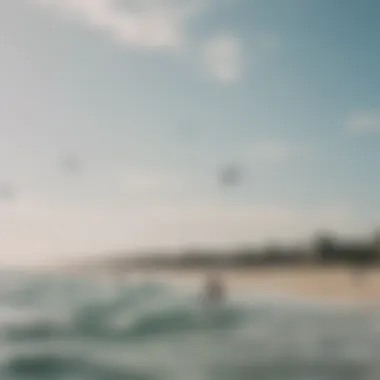

Safety Gear Essentials
When kiteboarding, wearing the right safety gear is as critical as ensuring your kite is in good shape. Each piece of equipment serves a distinctive role in safeguarding the rider. Here are some must-haves:
- Helmet: A sturdy helmet protects your head from possible impacts, especially when jumping or riding in high traffic areas. Looking to blend safety with style? Many brands out there offer helmets that tick both boxes.
- Impact Vest: These vests provide buoyancy and protection against hard landings. They can mitigate the force of a fall but also help keep you afloat should you find yourself in the water unexpectedly.
- Safety Knife: Sometimes, tangled lines can be a nightmare. A safety knife, strapped to your harness, ensures that you can quickly cut yourself free if needed.
- Wetsuit or Drysuit: Depending on water temperature, wearing a wetsuit or drysuit not only keeps you warm but also adds a layer of protection against scrapes.
- Board Leash: This often-overlooked piece of gear ensures your board stays attached to you, helping to prevent injuries that arise from runaway boards hitting others.
Investing in these essentials can make the difference between a day of fun and a regrettable trip to the hospital.
Understanding Wind Conditions and Their Dangers
Wind conditions play a pivotal role in the kiteboarding experience. Failing to understand these conditions can lead to severe peril. A gentle breeze one moment can turn into fierce gusts that could push even an experienced rider to their limits.
Here are some aspects to consider:
- Kite Size and Wind Range: Each kite has a recommended wind range. Knowing this ensures that your kite operates optimally in the condition you face. Too big a kite in high winds can make controlling it a real challenge.
- Local Wind Patterns: Factors like geographic features and weather patterns can create unpredictable wind conditions. Some spots might have a consistent breeze; others can shift unexpectedly.
- Gusts and Lulls: Recognizing gusty winds vs. lulls is crucial. Gusts can catch you off-guard, leading to potential spills, while lulls might make you sink if your kite loses lift.
"Wind is unpredictable, much like life. The better prepared you are, the more enjoyable your ride will be."
Vigilance goes a long way. Checking local weather forecasts, studying maps, and sometimes even chatting with locals can provide insight into what to expect. Also, it never hurts to keep an eye on visual clues around you, like how other riders are doing.
Understanding these elements not only enhances safety but also boosts confidence while riding.
Community Insights and Rider Experiences
The realm of kiteboarding is more than just a sport; it's a vibrant community filled with shared experiences and insights. This section focuses on why understanding community feedback and rider experiences is valuable in the context of kite selection and overall performance. When it comes to choosing the right gear, particularly kites, hearing firsthand accounts can provide critical information that goes beyond specifications and brand marketing.
Expert Testimonials on Kite Performance
Expert testimonials carry a weight that’s hard to ignore. Professional kiteboarders and instructors often share their personal journeys with various kite models and brands. These insights can illuminate performance nuances that aren’t immediately evident in product descriptions. For instance, one rider might detail how a particular kite handles during high winds while another emphasizes its stability in calmer conditions. Such accounts are invaluable when selecting equipment tailored to specific riding styles.
Additionally, testimonials often illuminate the nuances within kite design. For example, an experienced rider might explain how a C-Shape kite provides better upwind abilities compared to a traditional flat kite. They might reveal how the elasticity of the leading edge impacts their jumping ability, thereby connecting the technical aspects with real-world outcomes. When these experiences are shared, they contribute to a rich tapestry of knowledge that can guide both novice and seasoned riders alike.
"Rider experiences are essential. They offer a practical view that specs on a page can’t capture. It’s all about how it feels when you’re out there."
— A seasoned kiteboard instructor
Rider Reviews: What Matters Most
Rider reviews present a diverse spectrum of opinions and preferences, shedding light on what truly matters when selecting a kite. Factors such as durability, ease of setup, and responsiveness are common themes in these discussions. For example, many riders often prioritize durability because the harsh conditions on the water can take a toll on equipment. Those who frequently ride in rocky areas tend to express a preference for materials that withstand abrasions.
When attending local kiteboarding events, you might hear riders weighing in on how a kite performs after several months of use. This can reveal long-term reliability – a crucial element for anyone investing in top-tier kite gear.
Key points often raised in these reviews include:
- Wind Range: How well a kite performs in low versus high wind conditions.
- User-Friendliness: The setup and adjustment process from a rider’s perspective.
- Versatility: Whether the kite can adapt well to different riding styles, like freeride or freestyle.
Overall, the community’s feedback not only enriches the experience for individual kiteboarders but also fosters a sense of unity and shared learning among riders, making it an integral aspect of the kiteboarding journey.
Environmental Considerations in Kiteboarding
Kiteboarding, like many outdoor sports, treads the fine line between enjoying the great outdoors and preserving it. With the sport gaining traction globally, it’s essential to understand the environmental impact of our gear and practices. The beauty of kiteboarding lies not just in the exhilarating rides but also in the stunning natural settings that we access. This duality makes the concept of environmental responsibility crucial in maintaining the allure of kiteboarding for future generations.
Sustainability in Kite Manufacturing
The kiteboarding industry has seen a significant shift towards sustainability. Manufacturers today are becoming increasingly aware of the ecological footprint of their products, often made from materials that may not be environmentally friendly. Some brands are making strides in using recycled materials and bio-based components, edging towards a more sustainable approach. For instance, brands like North Kiteboarding are developing kites from fabrics that can be recycled, reducing waste in landfills.
Additionally, the production processes are evolving too. More companies are adopting cleaner methods. They are minimizing water usage during manufacturing and reducing harmful emissions. This transition is not just good for the planet but also resonates with environmentally conscious kiteboarders, who seek to align their passion for the sport with their desire to protect our surroundings. A kite crafted with sustainability in mind can make a profound statement about a rider’s values while enhancing their riding experience.
Promoting Eco-Friendly Practices among Riders
As kiteboarders, we not only enjoy nature; we also carry the responsibility of being stewards of it. Below are some practices that riders can adopt to maintain the beauty of our natural playgrounds:
- Respect Nature: Always pick up after yourself. This includes trash, excess gear, or broken equipment. Leaving a spot cleaner than you found it is a noble practice.
- Choose Eco-Conscious Brands: Supporting brands that prioritize sustainability ensures that your purchases align with eco-friendly principles. It sends a message that consumers care about the environmental impact of their gear.
- Educate Others: Share knowledge with fellow riders about the importance of sustainability in kiteboarding. Sometimes, simply talking about why these practices matter can inspire a shift in behavior across the community.
- Advocate for Protected Areas: As kiteboarders, we often frequent ecologically sensitive areas. Engage in community initiatives that aim to protect those areas, ensuring that our sport doesn’t lead to environmental degradation.
"The real voyage of discovery consists not in seeking new landscapes, but in having new eyes." - Marcel Proust
Adopting eco-friendly practices enables kiteboarders to fully embrace their love for the sport while also safeguarding the environments that grant us the gift of riding. Together, as a community, we can ensure that kiteboarding remains a sustainable and enjoyable pastime for years to come.
Future Trends in Kite Technology
The kiteboarding world is on the cusp of revolutionary changes, driven by a need for better performance and sustainability. As the sport continues to grow, so does the technology behind the kites themselves. Understanding the future trends in kite technology is paramount for riders—whether you’re a seasoned professional or an enthusiastic newcomer. This section aims to shed light on upcoming advances that promise to reshape kiteboarding experiences.
Emerging Materials and Designs
Kiteboarders are always on the lookout for a competitive edge, and this quest has led to ongoing research and development of new materials.
- Lightweight Fabrics: Manufacturers are exploring ultra-light materials that can withstand heavy winds while enhancing maneuverability. This kind of fabric not only reduces the overall weight of the kite but also allows for quicker aerial tricks, making it easier for riders to execute complex maneuvers.
- Durability Focus: Alongside lightness, there’s a push towards making kites more durable. Advances in material compositions are leading manufacturers to create fabrics that resist wear and tear, ensuring that kites can endure harsh conditions without compromising performance. A kite that can handle the rigors of use while also retaining its integrity is crucial for long-term enjoyment.
- Sustainable Options: As awareness of environmental issues grows, manufacturers are also focused on using sustainable materials. Biodegradable options or those made from recycled plastics are emerging in the market, appealing to eco-conscious riders who enjoy the thrill of the sport without taking a toll on nature.
Design Innovations are not far behind. Kites are evolving in geometry, expanding beyond traditional shapes to introduce models that can adapt to diverse wind conditions and riding styles. The integration of flexible and adaptive designs allows for greater versatility, catering to freeriders, freestyle enthusiasts, or wave riders alike.
The Role of Technology in Kiteboarding Advances
Advancements in technology are integral to the future direction of kiteboarding. The intersection of technology and kite performance is where innovation really takes flight. Today's kites aren't just flying sails; they're complex systems with smart features designed to elevate the rider's experience.
- Smart Kites: With the use of sensors and data analytics, next-generation kites may provide real-time feedback on performance metrics such as speed, altitude, and wind conditions. This data can help riders refine their techniques and improve their skills more efficiently.
- Automated Systems: Imagine kites that adjust themselves in response to changing wind conditions. Technologies that allow for automated adjustment of sail tension or angle could enable riders to maintain optimum performance without constant adjustments.
- Enhanced Control Systems: Developments in control bars and lines are paving the way for more intuitive handling. Responding to a rider's input with precision means more control in unpredictable situations, enhancing safety and performance.
"As kiteboarding technology continues to advance, the distinction between skill and gear will blur, allowing for unprecedented levels of performance."
These trends are setting the stage for a thrilling future in kiteboarding. Riders will not only benefit from superior equipment but will also experience unique riding conditions tailored to their preferences. Keeping an eye on these developments can prove essential for anyone invested in the sport. The kiteboarding landscape is changing, and understanding the gear will arm enthusiasts with the knowledge needed to make informed decisions in the years to come.













